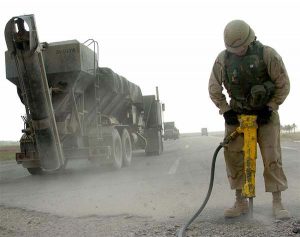
- Manufacture / Maintenance
- Transportation
- Operational
- Supplemental
Within each of these domains, sub-categories such as truck and trailer transportation, aircraft transportation, watercraft transportation and railroad transportation exist. Each of these categories may be again sub-divided into yet more specific criteria such as jet, propeller, helicopter for aircraft. Of concern is the coupling of the unit under test to the mounting platform. Care must be taken, especially for larger items, that flexing and the dynamic responses of the mounting platform during testing do not change the test results to not reflect the real-world environment. The effects of vibration and items to look for include:
- Chafed wiring.
- Loose fasteners/components.
- Intermittent electrical contacts.
- Electrical shorts.
- Deformed seals.
- Failed components.
- Optical or mechanical misalignment.
- Cracked and/or broken structures.
- Migration of particles and failed components.
- Particles and failed components lodged in circuitry or mechanisms.
- Excessive electrical noise.
- Fretting corrosion in bearings.
Essentially all material will experience vibration, whether during manufacture, transportation, maintenance or operational use. Vibration can have deleterious effects on the unit under test such as cracked finishes, displaced seals, etc. As such, vibration testing should be accomplished prior to other environmental tests to assure vibration doesn’t cause other hidden problems. For example, stress cracks in the material finish due to flexing of the material would show up as corrosion in Method 509.5 (Salt Fog) while a new un-flexed part would pass. Method 514.6 provides 4 procedures: Procedure I – General Vibration Used for material to be transported as secured cargo or deployed for use on a vehicle including ground vehicles and fixed and rotary wing aircraft. Standard laboratory vibration shakers are used for testing. Procedure II – Loose Cargo Transportation Used to simulate unsecured items carried in or on trucks, trailors or tracked vehicles. Simulation of this environment requires use of a package tester that imparts a 25.4 mm (1.0 inch) peak-to-peak, circular synchronous motion to the table at a frequency of 5 Hz. Procedure III – Large Assembly Transportation Intended to replicate the vibration and shock environment incurred by large assemblies installed or transported by wheeled or tracked vehicles. The item under test is loaded onto a representative vehicle and the vehicle is then driven over a test surface to simulate service conditions. Procedure IV – Assembled Aircraft Store Captive Carriage and Free Flight Used for fixed wing aircraft carriage and environmental life cycles of all aircraft stores and free flight phases of ground or sea-launched missiles. Standard laboratory vibration shakers are used for testing using representative mounting points to simulate aircraft mounting. Large test items on large complex fixtures are almost certain to have fixture resonances within the test range which can result in large over-tests or under-tests. Similar problems often occur with small test items. Analyses of vibration related failures must relate the failure mechanism to the dynamics of the failed item and to the dynamic environment. It is insufficient to determine that something broke due to high cycle fatigue or wear. Materiel is deemed to have failed if it suffers permanent deformation or fracture; if any fixed part or assembly loosens; if any moving or movable part of an assembly becomes free or sluggish in operation; if any movable part or control shifts in setting, position or adjustment, and if test item performance does not meet specification requirements while exposed to functional levels and following endurance tests. A vibration qualification test is complete when all elements of the test item have successfully passed a complete test. When a failure occurs, stop the test, analyze the failure, and repair the test item. Continue the test until all fixes have been exposed to a complete test.
